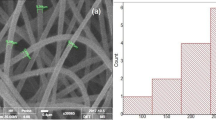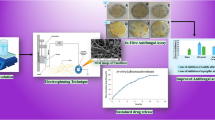Abstract
Polymer-based drug delivery systems are suitable to optimize the therapeutic properties of drugs and to render them safer, more effective and reliable. Long-term or repeated use of oral administration of fluconazole for treating chronic candidiasis in the patient and partially abandoned treatment lead to the resistant strains of the fungus Candida albicans and severity of the disease. In this study, the use of nanofibers and microfibers containing fluconazole for local drug delivery to increase the efficiencies and reduce the side effects caused by taking the drug was studied. Morphology, microstructure and chemical composition of PVA nanofibers containing fluconazole were characterized by scanning electron microscopy (SEM) and Fourier transform infrared spectroscopy (FTIR). As well as, the DSC test was indicated presence of fluconazole in PVA fibrous mats. The rate of drug release was investigated by UV–Vis spectrophotometery and swelling technique. SEM images showed that the nanofibers with uniform structure without beads were produced. The mechanical properties of the pristine PVA nanofiber and fibrous mat containing drug were evaluated. The release of fluconazole from PVA nanofibers in pH of 7.4 and at 37 °C was investigated. The results presented that the drug release rate is dependent on the morphology and structure of PVA nanofibers and could be adjusted in desired dosage. The presented products are applicable in the high production form for medical textile industry.
Graphical abstract







Similar content being viewed by others
References
Langer R. Polymer-controlled drug delivery systems. Acc Chem Res. 1993;26(10):537–42.
Zeng J, Xu X, Chen X, Liang Q, Bian X, Yang L, Jing X. Biodegradable electrospun fibers for drug delivery. J Control Release. 2003;92(3):227–31.
Ghasemi‐Mobarakeh L, Semnani D, Morshed M. A novel method for porosity measurement of various surface layers of nanofibers mat using image analysis for tissue engineering applications. J Appl Polym Sci. 2007;106(4):2536–42.
Ashjaran A, Namayi A. Survey on nanofiber material as drug delivery systems. Res J Pharm/Biol Chem Sci. 2014;5:1262–74.
Kluger PJ, Wyrwa R, Weisser J, Maierle J, Votteler M, Rode C, Schnabelrauch M, Walles H, Schenke-Layland K. Electrospun poly (d/l-lactide-co-l-lactide) hybrid matrix: a novel scaffold material for soft tissue engineering. J Mater Sci. 2010;21(9):2665–71.
Koosha M, Mirzadeh H. Electrospinning, mechanical properties, and cell behavior study of chitosan/PVA nanofibers. J Biomed Mater Res A. 2015;103(9):3081–93.
Li D, Xia Y. Electrospinning of nanofibers: reinventing the wheel? Adv Mater. 2004;16(14):1151–70.
Bosworth L, Downes S, editors. Electrospinning for tissue regeneration. Cambridge, England: Elsevier; 2011.
Kenawy ER, Abdel-Hay FI, El-Newehy MH, Wnek GE. Processing of polymer nanofibers through electrospinning as drug delivery systems. Mater Chem Phys. 2009;113(1):296–302.
Taylor G. Electrically driven jets. In Proceedings of the Royal Society of London A: Mathematical, Physical and Engineering Sciences. The Royal Society; 1969 (Vol. 313, no. 1515, p. 453–475).
Hu X, Liu S, Zhou G, Huang Y, Xie Z, Jing X. Electrospinning of polymeric nanofibers for drug delivery applications. J Control Release. 2014;185:12–21.
Park JC, Ito T, Kim KO, Kim KW, Kim BS, Khil MS, Kim HY, Kim IS. Electrospun poly (vinyl alcohol) nanofibers: effects of degree of hydrolysis and enhanced water stability. Polym J. 2010;42(3):273–6.
Chen H, Zhang P, He L, Sun J, Wang J, Qin C, Dai L. Preparation of poly (vinyl alcohol) core/sheath micro/nano composite fibers containing silver nanowires. Fibers Polym. 2015;16(10):2251–7.
Kenawy ER, Abdel-Hay FI, El-Newehy MH, Wnek GE. Controlled release of ketoprofen from electrospun poly (vinyl alcohol) nanofibers. Mater Sci Eng A. 2007;459(1):390–6.
Ding B, Kim HY, Lee SC, Shao CL, Lee DR, Park SJ, Kwag GB, Choi KJ. Preparation and characterization of a nanoscale poly (vinyl alcohol) fiber aggregate produced by an electrospinning method. J Polym Sci Part B. 2002;40(13):1261–8.
Pathan SG, Fitzgerald LM, Ali SM, Damrauer SM, Bide MJ, Nelson DW, Ferran C, Phaneuf TM, Phaneuf MD. Cytotoxicity associated with electrospun polyvinyl alcohol. J Biomed Mater Res Part B. 2015;103(8):1652–62.
Gimenez V, Mantecon A, Cadiz V. Crosslinking of poly (vinyl alcohol) using dianhydrides as hardeners. J Appl Polym Sci. 1996;59(3):425–31.
McCreath KJ, Specht CA, Robbins PW. Molecular cloning and characterization of chitinase genes from Candida albicans. Proc Natl Acad Sci. 1995;92(7):2544–8.
Calderone RA, Clancy CJ. editors. Candida and candidiasis. Washington, DC, USA: American Society for Microbiology Press; 2011.
De Cremer K, De Brucker K, Staes I, Peeters A, Van den Driessche F, Coenye T, Cammue BP, Thevissen K. Stimulation of superoxide production increases fungicidal action of miconazole against Candida albicans biofilms. Sci Rep. 2016;6:27463.
Ferrer J. Vaginal candidosis: epidemiological and etiological factors. Int J Gynecol Obstet. 2000;71:21–7.
Coneac G, et al. Development and evaluation of new microemulsion-based hydrogel formulations for topical delivery of fluconazole. AAPS PharmSciTech. 2015;16(4):889–904.
Matar M, Ostrosky-Zeichner L, Paetznick VL, Rodriguez JR, Chen E, Rex JH. Correlation between Etest, disk diffusion, and microdilution methods for antifungal susceptibility testing of fluconazole and voriconazole. Antimicrob Agents Chemother. 2003;47:1647–51.
Baghersad S, Mansurnezhad R, Ghasemi-Mobarakeh L, Molahosseini H, Morshed M. Coating of silk fabrics by PVA/ciprofloxacin HCl nanofibers for biomedical applications. Iran J Polym Sci Technol 2016;29(2):171–84.
Norouzi M, Ghasemi-Mobarakeh L, Morshed M. Fabrication of antibacterial poly(vinyl alcohol) microfibers mat for wound dressing application. Iran J Polym Sci Technol. 2016;29(1):15–25.
Zhang Y, Ouyang H, Lim CT, Ramakrishna S, Huang ZM. Electrospinning of gelatin fibers and gelatin/PCL composite fibrous scaffolds. J Biomed Mater Res Part B. 2005;72(1):156–65.
Wayne PA. Clinical and laboratory standards institute. Performance standards for antimicrobial susceptibility testing. 27th ed. CLSI supplement M100. 2007.
Shehap AM. Thermal and spectroscopic studies of polyvinyl alcohol/sodium carboxy methyl cellulose blends. Egypt J Solids. 2008;31(1):75–91.
Cyr TD, et al. Spectral characterization of fluconazole. J Pharm Biomed Anal. 1996;14(3):247–55.
Prabhu P, et al. Investigation of hydrogel membranes containing combination of gentamicin and dexamethasone for ocular delivery. Int J Pharm Investig. 2015;5(4):214.
Patel S, Shah D, Tiwari S. Bioadhesive films containing fluconazole for mucocutaneous candidiasis. Indian J Pharm Sci. 2015;77(1):55.
Brough C, et al. Use of polyvinyl alcohol as a solubility-enhancing polymer for poorly water soluble drug delivery (part 1). AAPS PharmSciTech. 2016;17(1):167–79.
Thompson CJ, Chase GG, Yarin AL, Reneker DH. Effects of parameters on nanofiber diameter determined from electrospinning model. Polymer. 2007;48(23):6913–22.
Acknowledgements
The authors are appreciated the support of the Isfahan University of technology and Ms. Neda Tansazan for providing DSC test
Author information
Authors and Affiliations
Corresponding author
Ethics declarations
Conflict of interest
The authors declare that they have no competing interests.
Rights and permissions
About this article
Cite this article
Semnani, D., Afrashi, M., Alihosseini, F. et al. Investigating the performance of drug delivery system of fluconazole made of nano–micro fibers coated on cotton/polyester fabric. J Mater Sci: Mater Med 28, 175 (2017). https://doi.org/10.1007/s10856-017-5957-9
Received:
Accepted:
Published:
DOI: https://doi.org/10.1007/s10856-017-5957-9




